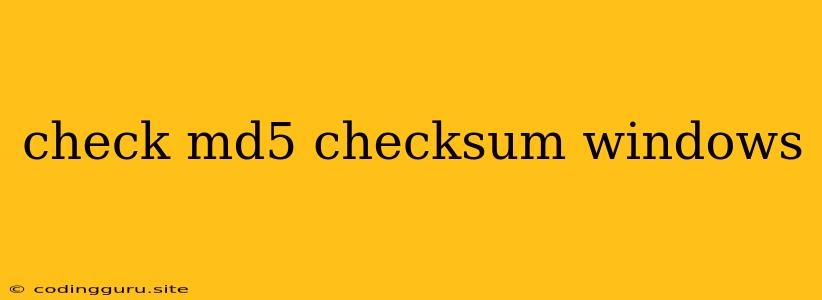How to Check MD5 Checksum on Windows?
Have you ever downloaded a file and wondered if it's the correct version or if it's been tampered with? That's where MD5 checksums come in handy. An MD5 checksum is a unique digital fingerprint of a file. It helps verify the integrity of a file by ensuring that it hasn't been altered during download or transfer.
What is MD5 Checksum?
MD5 stands for Message-Digest Algorithm 5. It's a cryptographic hash function that takes any input data (like a file) and generates a 32-character hexadecimal string. This string is the checksum or hash. If the file is modified in any way, even a single bit change, the MD5 checksum will change entirely.
Why Use MD5 Checksum?
- Integrity verification: Ensure the downloaded file is identical to the original.
- File corruption detection: If the checksum doesn't match, it indicates corruption during download or transfer.
- Virus detection: Some viruses might modify files, altering the MD5 checksum.
How to Check MD5 Checksum on Windows?
There are several ways to check MD5 checksum on Windows:
1. Using Command Prompt (CMD):
-
Open Command Prompt: Press the Windows key + R to open the Run dialog box, type cmd and press Enter.
-
Navigate to the file location: Use the cd command to change directories to where your file is located.
-
Type the command: Use the following command, replacing
filename.extensionwith the actual file name and extension:certutil -hashfile filename.extension MD5 -
Press Enter: The command will display the MD5 checksum.
Example:
To check the MD5 checksum of a file named my_file.zip located in the Downloads folder, you'd use the command:
certutil -hashfile Downloads\my_file.zip MD5
2. Using PowerShell:
-
Open PowerShell: Search for "PowerShell" in the Windows search bar and open it.
-
Navigate to the file location: Use the cd command to change directories to the file's location.
-
Type the command: Use the following command, replacing
filename.extensionwith the actual file name and extension:Get-FileHash -Algorithm MD5 -Path filename.extension -
Press Enter: The command will display the MD5 checksum.
Example:
To check the MD5 checksum of a file named my_file.zip located in the Downloads folder, you'd use the command:
Get-FileHash -Algorithm MD5 -Path Downloads\my_file.zip
3. Using Third-Party Tools:
Several free tools can calculate MD5 checksums for you. Some popular options include:
- HashCalc: A powerful and user-friendly tool that calculates various hash algorithms, including MD5.
- MD5 & SHA Checksum Utility: A simple and lightweight tool specifically designed for MD5 and SHA checksum calculations.
Tips for Verifying MD5 Checksums:
- Compare the generated checksum with the original: The MD5 checksum you calculate should match the checksum provided by the source of the file (often available on the download page or website).
- Double-check the file name and path: Ensure you're calculating the checksum of the correct file.
- Use reliable sources: Download files only from trusted websites or sources.
Conclusion:
Verifying the MD5 checksum of a file is a crucial step to ensure its integrity. By comparing the generated checksum with the original, you can be confident that the file is genuine and hasn't been corrupted or tampered with. Whether you use the Command Prompt, PowerShell, or third-party tools, you have several options available on Windows to check MD5 checksums and protect yourself from potentially malicious downloads.
